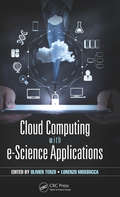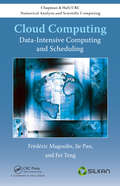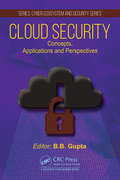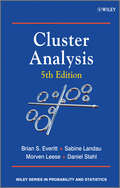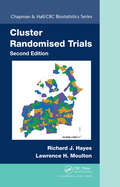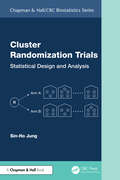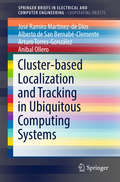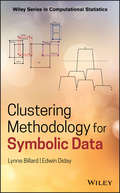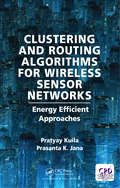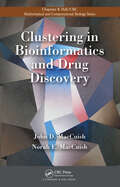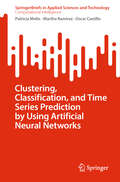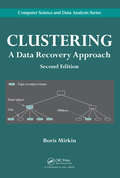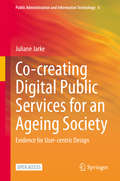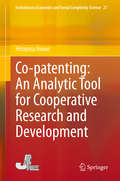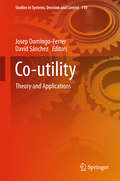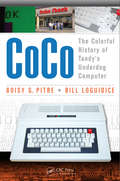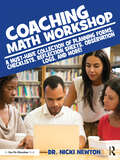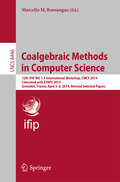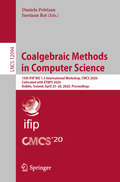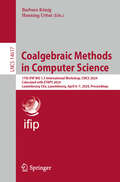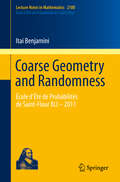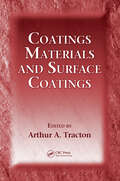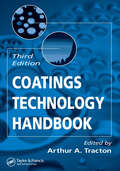- Table View
- List View
Cloud Computing with e-Science Applications
by Olivier Terzo Lorenzo MossuccaThe amount of data in everyday life has been exploding. This data increase has been especially significant in scientific fields, where substantial amounts of data must be captured, communicated, aggregated, stored, and analyzed. Cloud Computing with e-Science Applications explains how cloud computing can improve data management in data-heavy fields such as bioinformatics, earth science, and computer science. The book begins with an overview of cloud models supplied by the National Institute of Standards and Technology (NIST), and then: Discusses the challenges imposed by big data on scientific data infrastructures, including security and trust issues Covers vulnerabilities such as data theft or loss, privacy concerns, infected applications, threats in virtualization, and cross-virtual machine attack Describes the implementation of workflows in clouds, proposing an architecture composed of two layers—platform and application Details infrastructure-as-a-service (IaaS), platform-as-a-service (PaaS), and software-as-a-service (SaaS) solutions based on public, private, and hybrid cloud computing models Demonstrates how cloud computing aids in resource control, vertical and horizontal scalability, interoperability, and adaptive scheduling Featuring significant contributions from research centers, universities, and industries worldwide, Cloud Computing with e-Science Applications presents innovative cloud migration methodologies applicable to a variety of fields where large data sets are produced. The book provides the scientific community with an essential reference for moving applications to the cloud.
Cloud Computing: Data-Intensive Computing and Scheduling
by Frederic Magoules Jie Pan Fei TengAs more and more data is generated at a faster-than-ever rate, processing large volumes of data is becoming a challenge for data analysis software. Addressing performance issues, Cloud Computing: Data-Intensive Computing and Scheduling explores the evolution of classical techniques and describes completely new methods and innovative algorithms. The
Cloud Security: Concepts, Applications and Perspectives (Cyber Ecosystem and Security)
by Brij B GuptaCloud computing is an indispensable part of the modern Information and Communication Technology (ICT) systems. Cloud computing services have proven to be of significant importance, and promote quickly deployable and scalable IT solutions with reduced infrastructure costs. However, utilization of cloud also raises concerns such as security, privacy, latency, and governance, that keep it from turning into the predominant option for critical frameworks. As such, there is an urgent need to identify these concerns and to address them.Cloud Security: Concepts, Applications and Perspectives is a comprehensive work with substantial technical details for introducing the state-of-the-art research and development on various approaches for security and privacy of cloud services; novel attacks on cloud services; cloud forensics; novel defenses for cloud service attacks; and cloud security analysis. It discusses the present techniques and methodologies, and provides a wide range of examples and illustrations to effectively show the concepts, applications, and perspectives of security in cloud computing. This highly informative book will prepare readers to exercise better protection by understanding the motivation of attackers and to deal with them to mitigate the situation. In addition, it covers future research directions in the domain. This book is suitable for professionals in the field, researchers, students who are want to carry out research in the field of computer and cloud security, faculty members across universities, and software developers engaged in software development in the field.
Cluster Analysis
by Sabine Landau Morven Leese Daniel Stahl Brian S. EverittCluster analysis comprises a range of methods for classifying multivariate data into subgroups. By organizing multivariate data into such subgroups, clustering can help reveal the characteristics of any structure or patterns present. These techniques have proven useful in a wide range of areas such as medicine, psychology, market research and bioinformatics.This fifth edition of the highly successful Cluster Analysis includes coverage of the latest developments in the field and a new chapter dealing with finite mixture models for structured data.Real life examples are used throughout to demonstrate the application of the theory, and figures are used extensively to illustrate graphical techniques. The book is comprehensive yet relatively non-mathematical, focusing on the practical aspects of cluster analysis.Key Features:* Presents a comprehensive guide to clustering techniques, with focus on the practical aspects of cluster analysis.* Provides a thorough revision of the fourth edition, including new developments in clustering longitudinal data and examples from bioinformatics and gene studies* Updates the chapter on mixture models to include recent developments and presents a new chapter on mixture modeling for structured data.Practitioners and researchers working in cluster analysis and data analysis will benefit from this book.
Cluster Randomised Trials (Chapman & Hall/CRC Biostatistics Series)
by Richard J. Hayes Lawrence H. MoultonCluster Randomised Trials, Second Edition discusses the design, conduct, and analysis of trials that randomise groups of individuals to different treatments. It explores the advantages of cluster randomisation, with special attention given to evaluating the effects of interventions against infectious diseases. Avoiding unnecessary mathematical detail, the book covers basic concepts underlying the use of cluster randomisation, such as direct, indirect, and total effects. In the time since the publication of the first edition, the use of cluster randomised trials (CRTs) has increased substantially, which is reflected in the updates to this edition. There are greatly expanded sections on randomisation, sample size estimation, and alternative designs, including new material on stepped wedge designs. There is a new section on handling ordinal outcome data, and an appendix with descriptions and/or generating code of the example data sets. Although the book mainly focuses on medical and public health applications, it shows that the rigorous evidence of intervention effects provided by CRTs has the potential to inform public policy in a wide range of other areas. The book encourages readers to apply the methods to their own trials, reproduce the analyses presented, and explore alternative approaches.
Cluster Randomization Trials: Statistical Design and Analysis (Chapman & Hall/CRC Biostatistics Series)
by Sin-Ho JungOftentimes, small groups (called clusters) of individuals (called subunits) are randomized between treatment arms. Typically, clusters are families, classes, communities, surgeons operating patients, and so on. Such trials are called cluster randomization trials (CRTs). The subunits in each cluster share common frailties so that their outcomes tend to be positively correlated. Since clusters are independent, the data in two arms are independent in CRTs. In a clinical trial, multiple sites (such as teeth or ears) from each subject may be randomized between different treatment arms. In this case, the sites (subunits) of each subject (cluster) share common genetic, physiological, or environmental characteristics so that their observations tend to be positively correlated. This kind of trials are called subunit randomization trials (SRTs). In SRTs, dependency exists both within and between treatment arms. Individually randomized group treatment (IRGT) trials are composite of traditional independent subject randomization and CRTs. In an IRGT trial, the control arm is to treat patients individually, whereas the experimental arm is to treat patients using a group training, education, or treatment to increase the treatment effect by close interactions among patients. As a result, the outcome data of the control arm are independent as in traditional trials, but those in the experimental arm are correlated within each group (cluster) as in CRTs. Hence, two arms in IRGT trials have different dependency structures. Unlike standard CRTs, clusters of IRGT trials are usually organized after randomization. But statistically, they have identical statistical issues between the two types of trials, i.e., accounting for the dependency within each cluster. Although this book is entitled Cluster Randomization Trials, it covers all three types of trials (i.e., CRTs, SRTs, and IRGT trials) resulting in clustered data. For outcome variables of binary, continuous, and time-to-event types, we investigate generalized estimating equation type statistical tests and their sample size formulas. Also presented are random number generation algorithms for different types of outcome variables and randomization methods. The methods are discussed in terms of clinical trials, but can be used to design and analyze any types of experiments involving clustered data. This book also discusses statistical methods for various types of biomarker studies, including ROC methods, with clustered data. Key Features: Includes extensive statistical tests and their sample size formulas for various types of clinical trials resulting in clustered data. Handles different variable types of endpoints separately. Discusses algorithms to generate clustered binary and survival data that are useful for simulations. Covers statistical tests and sample size formulas for medical tests with clustered data.
Cluster-based Localization and Tracking in Ubiquitous Computing Systems (SpringerBriefs in Electrical and Computer Engineering)
by Anibal Ollero José Ramiro Martínez-de Dios Alberto de San Bernabé-Clemente Arturo Torres-GonzálezLocalization and tracking are key functionalities in ubiquitous computing systems and techniques. In recent years a very high variety of approaches, sensors and techniques for indoor and GPS-denied environments have been developed. This book briefly summarizes the current state of the art in localization and tracking in ubiquitous computing systems focusing on cluster-based schemes. Additionally, existing techniques for measurement integration, node inclusion/exclusion and cluster head selection are also described in this book.
Clustering Methodology for Symbolic Data (Wiley Series in Computational Statistics)
by Lynne Billard Edwin DidayCovers everything readers need to know about clustering methodology for symbolic data—including new methods and headings—while providing a focus on multi-valued list data, interval data and histogram data This book presents all of the latest developments in the field of clustering methodology for symbolic data—paying special attention to the classification methodology for multi-valued list, interval-valued and histogram-valued data methodology, along with numerous worked examples. The book also offers an expansive discussion of data management techniques showing how to manage the large complex dataset into more manageable datasets ready for analyses. Filled with examples, tables, figures, and case studies, Clustering Methodology for Symbolic Data begins by offering chapters on data management, distance measures, general clustering techniques, partitioning, divisive clustering, and agglomerative and pyramid clustering. Provides new classification methodologies for histogram valued data reaching across many fields in data science Demonstrates how to manage a large complex dataset into manageable datasets ready for analysis Features very large contemporary datasets such as multi-valued list data, interval-valued data, and histogram-valued data Considers classification models by dynamical clustering Features a supporting website hosting relevant data sets Clustering Methodology for Symbolic Data will appeal to practitioners of symbolic data analysis, such as statisticians and economists within the public sectors. It will also be of interest to postgraduate students of, and researchers within, web mining, text mining and bioengineering.
Clustering and Routing Algorithms for Wireless Sensor Networks: Energy Efficiency Approaches
by Pratyay Kuila Prasanta K JanaWireless Sensor Networks have a wide range of applications in different areas. Their main constraint is the limited and irreplaceable power source of the sensor nodes. In many applications, energy conservation of the sensor nodes and their replacement or replenishment due to the hostile nature of the environment is the most challenging issue. Energy efficient clustering and routing are the two main important topics studied extensively for this purpose. This book focuses on the energy efficient clustering and routing with a great emphasis on the evolutionary approaches. It provides a comprehensive and systematic introduction of the fundamentals of WSNs, major issues and effective solutions.
Clustering in Bioinformatics and Drug Discovery (Chapman & Hall/CRC Computational Biology Series)
by John David MacCuish Norah E. MacCuishWith a DVD of color figures, Clustering in Bioinformatics and Drug Discovery provides an expert guide on extracting the most pertinent information from pharmaceutical and biomedical data. It offers a concise overview of common and recent clustering methods used in bioinformatics and drug discovery.Setting the stage for subsequent material, the firs
Clustering, Classification, and Time Series Prediction by Using Artificial Neural Networks (SpringerBriefs in Applied Sciences and Technology)
by Oscar Castillo Patricia Melin Martha RamirezThis book provides a new model for clustering, classification, and time series prediction by using artificial neural networks to computationally simulate the behavior of the cognitive functions of the brain is presented. This model focuses on the study of intelligent hybrid neural systems and their use in time series analysis and decision support systems. Therefore, through the development of eight case studies, multiple time series related to the following problems are analyzed: traffic accidents, air quality and multiple global indicators (energy consumption, birth rate, mortality rate, population growth, inflation, unemployment, sustainable development, and quality of life). The main contribution consists of a Generalized Type-2 fuzzy integration of multiple indicators (time series) using both supervised and unsupervised neural networks and a set of Type-1, Interval Type-2, and Generalized Type-2 fuzzy systems. The obtained results show the advantages of the proposed model of Generalized Type-2 fuzzy integration of multiple time series attributes. This book is intended to be a reference for scientists and engineers interested in applying type-2 fuzzy logic techniques for solving problems in classification and prediction. We consider that this book can also be used to get novel ideas for new lines of research, or to continue the lines of research proposed by the authors of the book.
Clustering: A Data Recovery Approach, Second Edition
by Boris MirkinOften considered more of an art than a science, books on clustering have been dominated by learning through example with techniques chosen almost through trial and error. Even the two most popular, and most related, clustering methods-K-Means for partitioning and Ward's method for hierarchical clustering-have lacked the theoretical underpinning req
Co-creating Digital Public Services for an Ageing Society: Evidence for User-centric Design (Public Administration and Information Technology #6)
by Juliane JarkeThis open access book attends to the co-creation of digital public services for ageing societies. Increasingly public services are provided in digital form; their uptake however remains well below expectations. In particular, amongst older adults the need for public services is high, while at the same time the uptake of digital services is lower than the population average. One of the reasons is that many digital public services (or e-services) do not respond well to the life worlds, use contexts and use practices of its target audiences. This book argues that when older adults are involved in the process of identifying, conceptualising, and designing digital public services, these services become more relevant and meaningful.The book describes and compares three co-creation projects that were conducted in two European cities, Bremen and Zaragoza, as part of a larger EU-funded innovation project. The first part of the book traces the origins of co-creation to three distinct domains, in which co-creation has become an equally important approach with different understandings of what it is and entails: (1) the co-production of public services, (2) the co-design of information systems and (3) the civic use of open data. The second part of the book analyses how decisions about a co-creation project’s governance structure, its scope of action, its choice of methods, its alignment with strategic policies and its embedding in existing public information infrastructures impact on the process and its results. The final part of the book identifies key challenges to co-creation and provides a more general assessment of what co-creation may achieve, where the most promising areas of application may be and where it probably does not match with the contingent requirements of digital public services. Contributing to current discourses on digital citizenship in ageing societies and user-centric design, this book is useful for researchers and practitioners interested in co-creation, public sector innovation, open government, ageing and digital technologies, citizen engagement and civic participation in socio-technical innovation.
Co-patenting: A Network Science Approach (Evolutionary Economics and Social Complexity Science #21)
by Hiroyasu InoueThis is the first book that comprehensively analyses co-patenting in Japan and the U.S., which directly signifies collaborations between firms and inventors, using the methodology of network science. Network science approaches enable us to analyse the structures of co-patenting networks. In addition, generative models in network science estimate the probability of new connections between nodes, which enables us to discuss the temporal development of networks. On the other hand, regression analyses, which are broadly used in the field of economics, may be effective for determining what attributes are important for firms and inventors that are going to be connected, but such techniques cannot consider the complexity of networks. This book compiles a series of studies by the author on geographical location and co-patenting using data that were published in eight academic journal articles. This book gives the reader ideas about how we can utilize patent data to understand how firms and inventors collaborate under the effect of complex networks.
Co-utility: Theory and Applications (Studies in Systems, Decision and Control #110)
by Josep Domingo-Ferrer David SánchezThis book explores the theoretical foundations of co-utility as well as its application to a number of areas, including distributed reputation management, anonymous keyword search, collaborative data anonymization, digital oblivion, peer-to-peer (P2P) content distribution, ridesharing for sustainable mobility, environmental economy, business model design and the collaborative economy. It evolved from presentations at the 1st Co-Utility Workshop, "held in Tarragona, Spain, on March 10-11, 2016. " How can we guarantee that a global society without a common legal framework operates smoothly? If generosity, honesty and helpfulness do not arise spontaneously, one approach would be to design transactions so that helping others remains the best rational option. This is precisely the goal of co-utility, which can be defined in game-theoretic terms as any interaction between peers in which the best option for a player to maximize her or his utility is to make sure the other players also enjoy a fair share of utility (for example, functionality, security or privacy). Therefore, a protocol or mechanism designed using the co-utility principle ensures that helping others is the best rational option, even if players are selfish.
CoCo: The Colorful History of Tandy's Underdog Computer
by Bill Loguidice Boisy G PitreCoCo: The Colorful History of Tandy's Underdog Computer is the first book to document the complete history of the Tandy Color Computer (CoCo), a popular 8-bit PC series from the 1980s that competed against the era's biggest names, including the Apple II, IBM PC, and Commodore 64. The book takes you inside the interesting stories and people behind t
Coach New Generation Practice Tests, Mathematics, [Grade] 4
by Triumph LearningNIMAC-sourced textbook
Coaching Math Workshop
by Nicki NewtonCoaching math workshops? This invaluable resource from beloved guru Dr. Nicki Newton has everything you need to help your teachers and students be successful! Dr. Nicki saves you time and prep work by providing a plethora of tools to help you with each step. She provides an overview of the workshop; getting to know you activities; forms for goal setting, reflections, PD planning, and feedback; calendars; to do lists; data and material logs; lists of things to buy; planning sheets for book studies; and more! With this book's handy checklists and tools, you'll have everything you need to coach math workshop at your fingertips!
Coalgebraic Methods in Computer Science: 12th IFIP WG 1.3 International Workshop, CMCS 2014, Colocated with ETAPS 2014, Grenoble, France, April 5-6, 2014, Revised Selected Papers (Lecture Notes in Computer Science #8446)
by Marcello M. BonsangueThis book constitutes the thoroughly refereed post-proceedings of the 12th International Workshop on Coalgebraic Methods in Computer Science, CMCS 2014, colocated with ETAPS 2014, held in Grenoble, France, in April 2014. The 10 revised full papers were carefully reviewed and selected from 20 submissions. Also included are three invited talks. The papers cover a wide range of topics in the theory, logics and applications of coalgebras.
Coalgebraic Methods in Computer Science: 15th IFIP WG 1.3 International Workshop, CMCS 2020, Colocated with ETAPS 2020, Dublin, Ireland, April 25–26, 2020, Proceedings (Lecture Notes in Computer Science #12094)
by Daniela Petrişan Jurriaan RotThis book constitutes the thoroughly refereed post-conference proceedings of the 15th International Workshop on Coalgebraic Methods in Computer Science, CMCS 2020, colocated with ETAPS 2020, held in Dublin, Ireland, in April 2020. The conference was held as several online events in September and October due to the COVID-19 pandemic. The 9 revised full papers were carefully reviewed and selected from 13 submissions. Also included is one invited talk. The papers cover a wide range of topics in the theory, logics, and applications of coalgebras.
Coalgebraic Methods in Computer Science: 17th IFIP WG 1.3 International Workshop, CMCS 2024, Colocated with ETAPS 2024, Luxembourg City, Luxembourg, April 6–7, 2024, Proceedings (Lecture Notes in Computer Science #14617)
by Barbara König Henning UrbatThis book constitutes the post-conference proceedings of the 17th International Workshop on Coalgebraic Methods in Computer Science, CMCS 2024, colocated with ETAPS 2024, held in Luxembourg in April 2024. The 10 papers included in these proceedings were carefully reviewed and selected from 15 submissions. The papers cover a wide range of topics on theory, logics, and applications of coalgebras.
Coarse Geometry and Randomness: École d’Été de Probabilités de Saint-Flour XLI – 2011 (Lecture Notes in Mathematics #2100)
by Itai BenjaminiThese lecture notes study the interplay between randomness and geometry of graphs. The first part of the notes reviews several basic geometric concepts, before moving on to examine the manifestation of the underlying geometry in the behavior of random processes, mostly percolation and random walk. The study of the geometry of infinite vertex transitive graphs, and of Cayley graphs in particular, is fairly well developed. One goal of these notes is to point to some random metric spaces modeled by graphs that turn out to be somewhat exotic, that is, they admit a combination of properties not encountered in the vertex transitive world. These include percolation clusters on vertex transitive graphs, critical clusters, local and scaling limits of graphs, long range percolation, CCCP graphs obtained by contracting percolation clusters on graphs, and stationary random graphs, including the uniform infinite planar triangulation (UIPT) and the stochastic hyperbolic planar quadrangulation (SHIQ).
Coarse Geometry of Topological Groups (Cambridge Tracts in Mathematics #223)
by Christian RosendalThis book provides a general framework for doing geometric group theory for many non-locally-compact topological transformation groups that arise in mathematical practice, including homeomorphism and diffeomorphism groups of manifolds, isometry groups of separable metric spaces and automorphism groups of countable structures. Using Roe's framework of coarse structures and spaces, the author defines a natural coarse geometric structure on all topological groups. This structure is accessible to investigation, especially in the case of Polish groups, and often has an explicit description, generalising well-known structures in familiar cases including finitely generated discrete groups, compactly generated locally compact groups and Banach spaces. In most cases, the coarse geometric structure is metrisable and may even be refined to a canonical quasimetric structure on the group. The book contains many worked examples and sufficient introductory material to be accessible to beginning graduate students. An appendix outlines several open problems in this young and rich theory.
Coatings Materials and Surface Coatings
by Arthur A. TractonDrawing from the third edition of The Coatings Technology Handbook, this text provides a detailed analysis of the raw materials used in the coatings, adhesives, paints, and inks industries. Coatings Materials and Surface Coatings contains chapters covering the latest polymers, carbon resins, and high-temperature materials used for coatings, adhesiv
Coatings Technology Handbook
by Arthur A. TractonServing as an all-in-one guide to the entire field of coatings technology, this encyclopedic reference covers a diverse range of topics-including basic concepts, coating types, materials, processes, testing and applications-summarizing both the latest developments and standard coatings methods. Take advantage of the insights and experience of over
